SRP782: Smart Cities and Infrastructure - Singapore Case Study Report
VerifiedAdded on 2022/08/29
|8
|1480
|29
Report
AI Summary
This report provides a comprehensive overview of the smart city concept, defining it as an urban area that leverages technology, particularly the Internet of Things (IoT), to efficiently manage resources and improve services. It highlights key aspects like infrastructure, connectivity, data analysis, and centralized management. The report uses Singapore as a case study, examining its smart city initiatives, including sustainable estates, remote healthcare, smart transport systems, and autonomous vehicles. It also critiques the development of smart cities, addressing concerns about security, privacy, and the need for thorough planning. The analysis emphasizes the role of government policies, technological advancements, and the potential for enhanced quality of life when cities are truly "smart."

SRP782 Smart Cities and Infrastructure 1
SRP782 SMART CITIES AND INFRASTRUCTURE
Name of student
Institution
Date
Location
SRP782 SMART CITIES AND INFRASTRUCTURE
Name of student
Institution
Date
Location
Paraphrase This Document
Need a fresh take? Get an instant paraphrase of this document with our AI Paraphraser
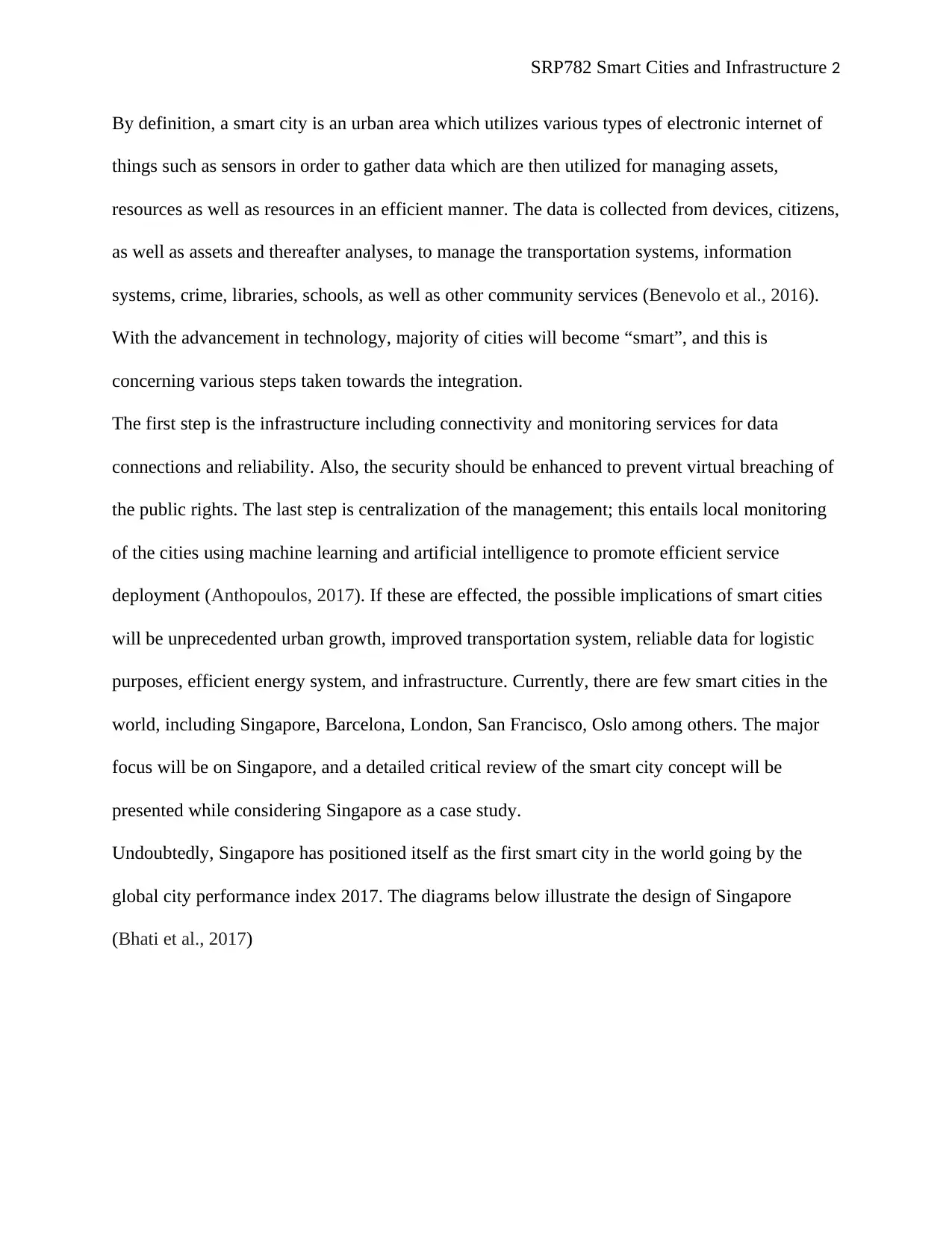
SRP782 Smart Cities and Infrastructure 2
By definition, a smart city is an urban area which utilizes various types of electronic internet of
things such as sensors in order to gather data which are then utilized for managing assets,
resources as well as resources in an efficient manner. The data is collected from devices, citizens,
as well as assets and thereafter analyses, to manage the transportation systems, information
systems, crime, libraries, schools, as well as other community services (Benevolo et al., 2016).
With the advancement in technology, majority of cities will become “smart”, and this is
concerning various steps taken towards the integration.
The first step is the infrastructure including connectivity and monitoring services for data
connections and reliability. Also, the security should be enhanced to prevent virtual breaching of
the public rights. The last step is centralization of the management; this entails local monitoring
of the cities using machine learning and artificial intelligence to promote efficient service
deployment (Anthopoulos, 2017). If these are effected, the possible implications of smart cities
will be unprecedented urban growth, improved transportation system, reliable data for logistic
purposes, efficient energy system, and infrastructure. Currently, there are few smart cities in the
world, including Singapore, Barcelona, London, San Francisco, Oslo among others. The major
focus will be on Singapore, and a detailed critical review of the smart city concept will be
presented while considering Singapore as a case study.
Undoubtedly, Singapore has positioned itself as the first smart city in the world going by the
global city performance index 2017. The diagrams below illustrate the design of Singapore
(Bhati et al., 2017)
By definition, a smart city is an urban area which utilizes various types of electronic internet of
things such as sensors in order to gather data which are then utilized for managing assets,
resources as well as resources in an efficient manner. The data is collected from devices, citizens,
as well as assets and thereafter analyses, to manage the transportation systems, information
systems, crime, libraries, schools, as well as other community services (Benevolo et al., 2016).
With the advancement in technology, majority of cities will become “smart”, and this is
concerning various steps taken towards the integration.
The first step is the infrastructure including connectivity and monitoring services for data
connections and reliability. Also, the security should be enhanced to prevent virtual breaching of
the public rights. The last step is centralization of the management; this entails local monitoring
of the cities using machine learning and artificial intelligence to promote efficient service
deployment (Anthopoulos, 2017). If these are effected, the possible implications of smart cities
will be unprecedented urban growth, improved transportation system, reliable data for logistic
purposes, efficient energy system, and infrastructure. Currently, there are few smart cities in the
world, including Singapore, Barcelona, London, San Francisco, Oslo among others. The major
focus will be on Singapore, and a detailed critical review of the smart city concept will be
presented while considering Singapore as a case study.
Undoubtedly, Singapore has positioned itself as the first smart city in the world going by the
global city performance index 2017. The diagrams below illustrate the design of Singapore
(Bhati et al., 2017)
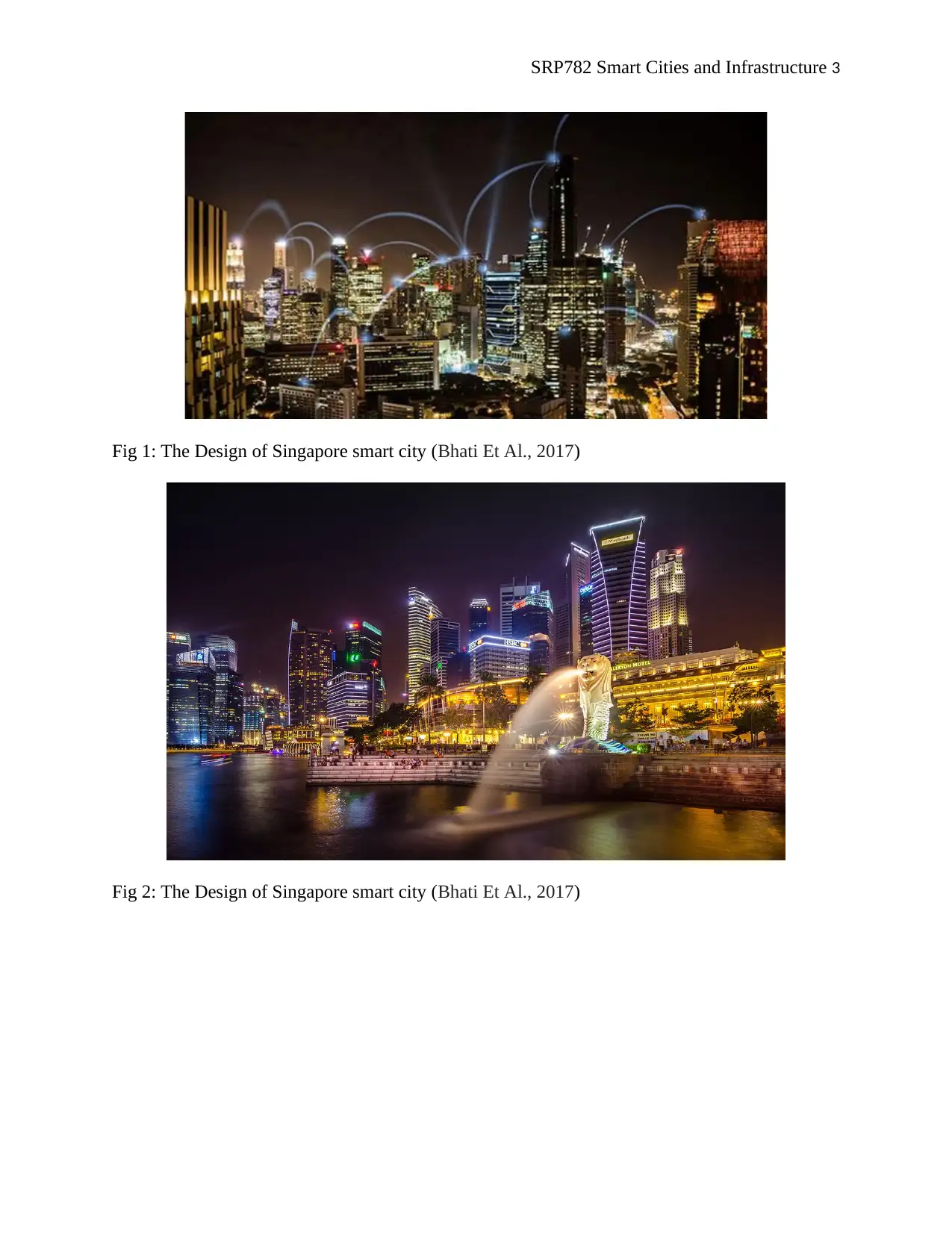
SRP782 Smart Cities and Infrastructure 3
Fig 1: The Design of Singapore smart city (Bhati Et Al., 2017)
Fig 2: The Design of Singapore smart city (Bhati Et Al., 2017)
Fig 1: The Design of Singapore smart city (Bhati Et Al., 2017)
Fig 2: The Design of Singapore smart city (Bhati Et Al., 2017)
⊘ This is a preview!⊘
Do you want full access?
Subscribe today to unlock all pages.

Trusted by 1+ million students worldwide
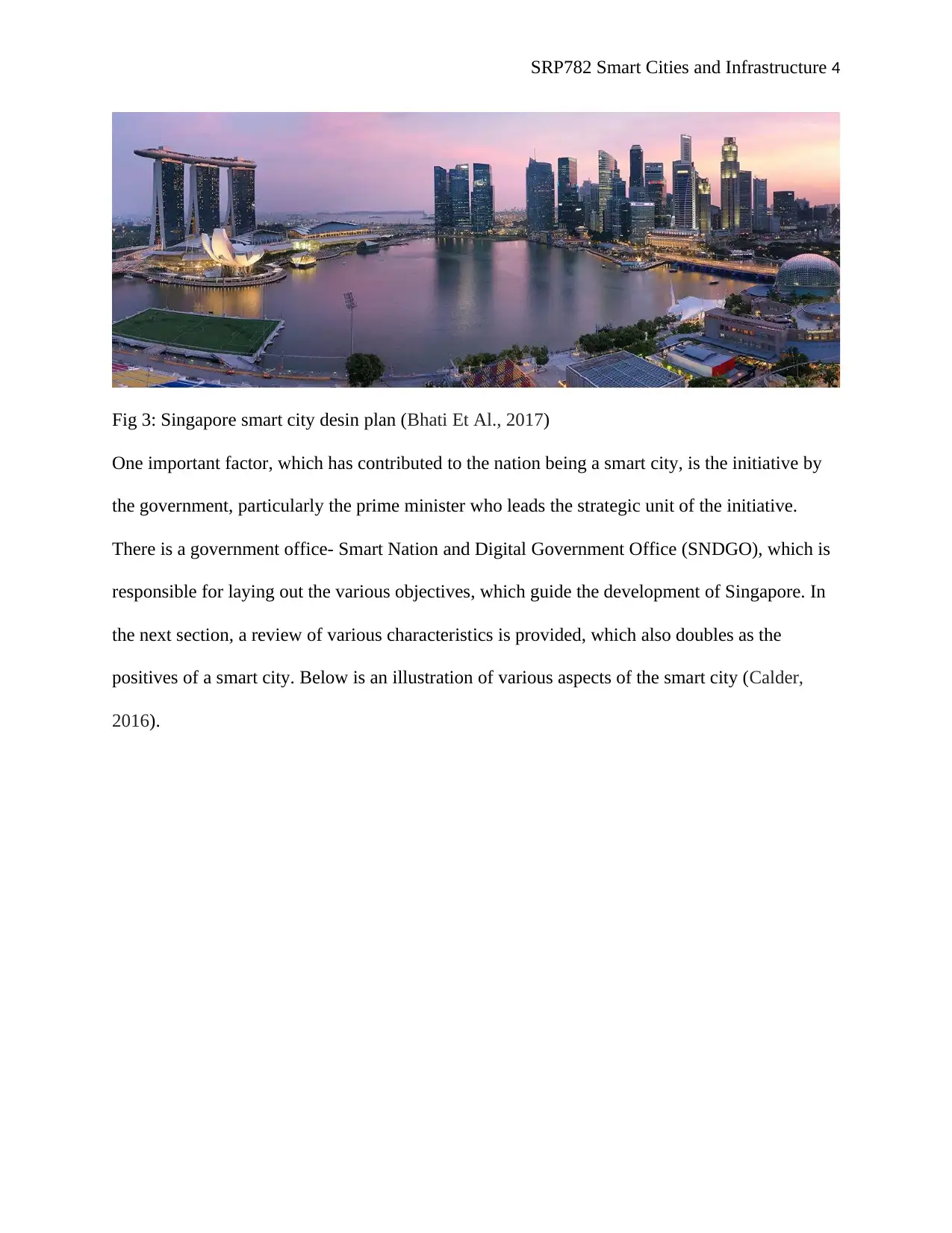
SRP782 Smart Cities and Infrastructure 4
Fig 3: Singapore smart city desin plan (Bhati Et Al., 2017)
One important factor, which has contributed to the nation being a smart city, is the initiative by
the government, particularly the prime minister who leads the strategic unit of the initiative.
There is a government office- Smart Nation and Digital Government Office (SNDGO), which is
responsible for laying out the various objectives, which guide the development of Singapore. In
the next section, a review of various characteristics is provided, which also doubles as the
positives of a smart city. Below is an illustration of various aspects of the smart city (Calder,
2016).
Fig 3: Singapore smart city desin plan (Bhati Et Al., 2017)
One important factor, which has contributed to the nation being a smart city, is the initiative by
the government, particularly the prime minister who leads the strategic unit of the initiative.
There is a government office- Smart Nation and Digital Government Office (SNDGO), which is
responsible for laying out the various objectives, which guide the development of Singapore. In
the next section, a review of various characteristics is provided, which also doubles as the
positives of a smart city. Below is an illustration of various aspects of the smart city (Calder,
2016).
Paraphrase This Document
Need a fresh take? Get an instant paraphrase of this document with our AI Paraphraser
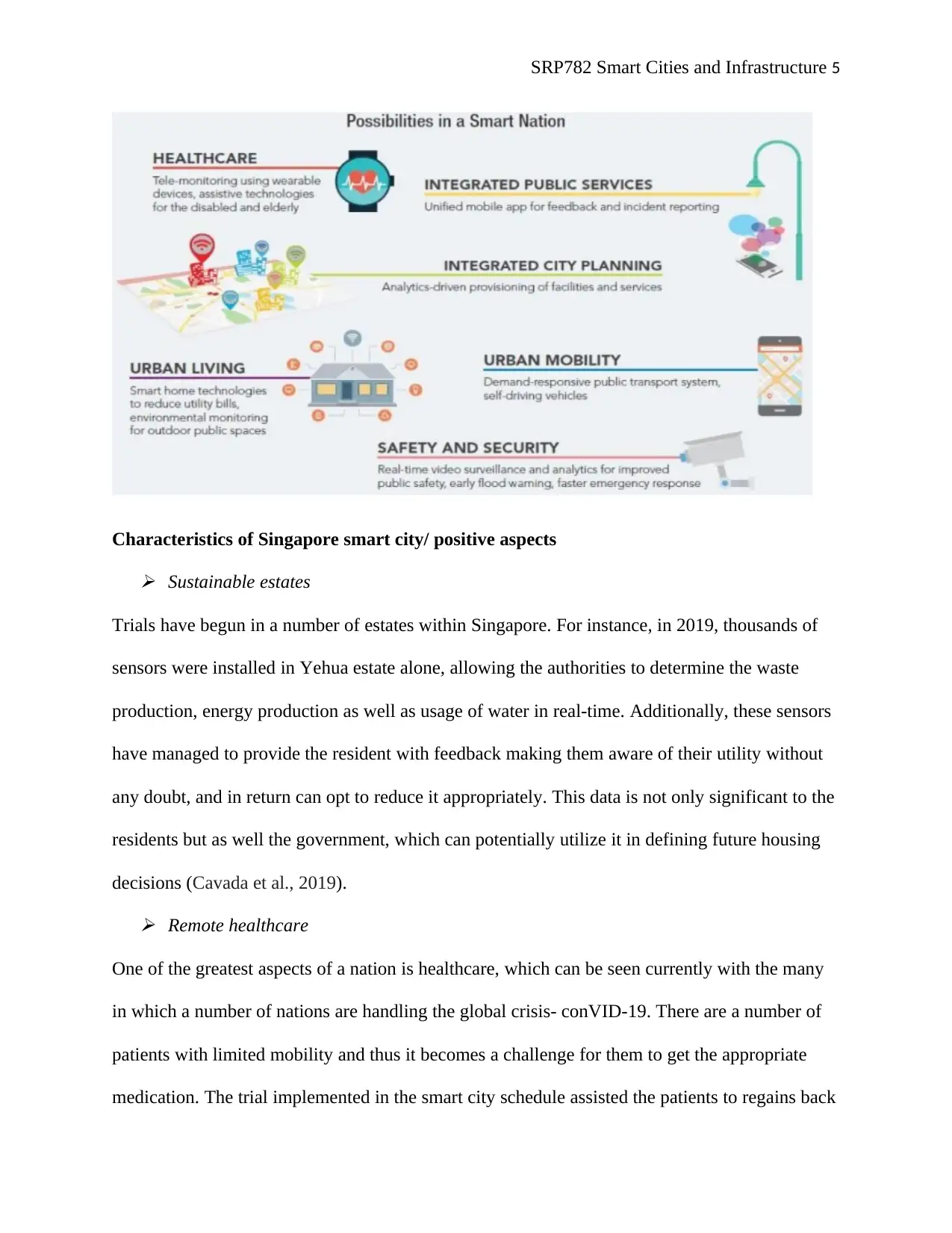
SRP782 Smart Cities and Infrastructure 5
Characteristics of Singapore smart city/ positive aspects Sustainable estates
Trials have begun in a number of estates within Singapore. For instance, in 2019, thousands of
sensors were installed in Yehua estate alone, allowing the authorities to determine the waste
production, energy production as well as usage of water in real-time. Additionally, these sensors
have managed to provide the resident with feedback making them aware of their utility without
any doubt, and in return can opt to reduce it appropriately. This data is not only significant to the
residents but as well the government, which can potentially utilize it in defining future housing
decisions (Cavada et al., 2019). Remote healthcare
One of the greatest aspects of a nation is healthcare, which can be seen currently with the many
in which a number of nations are handling the global crisis- conVID-19. There are a number of
patients with limited mobility and thus it becomes a challenge for them to get the appropriate
medication. The trial implemented in the smart city schedule assisted the patients to regains back
Characteristics of Singapore smart city/ positive aspects Sustainable estates
Trials have begun in a number of estates within Singapore. For instance, in 2019, thousands of
sensors were installed in Yehua estate alone, allowing the authorities to determine the waste
production, energy production as well as usage of water in real-time. Additionally, these sensors
have managed to provide the resident with feedback making them aware of their utility without
any doubt, and in return can opt to reduce it appropriately. This data is not only significant to the
residents but as well the government, which can potentially utilize it in defining future housing
decisions (Cavada et al., 2019). Remote healthcare
One of the greatest aspects of a nation is healthcare, which can be seen currently with the many
in which a number of nations are handling the global crisis- conVID-19. There are a number of
patients with limited mobility and thus it becomes a challenge for them to get the appropriate
medication. The trial implemented in the smart city schedule assisted the patients to regains back
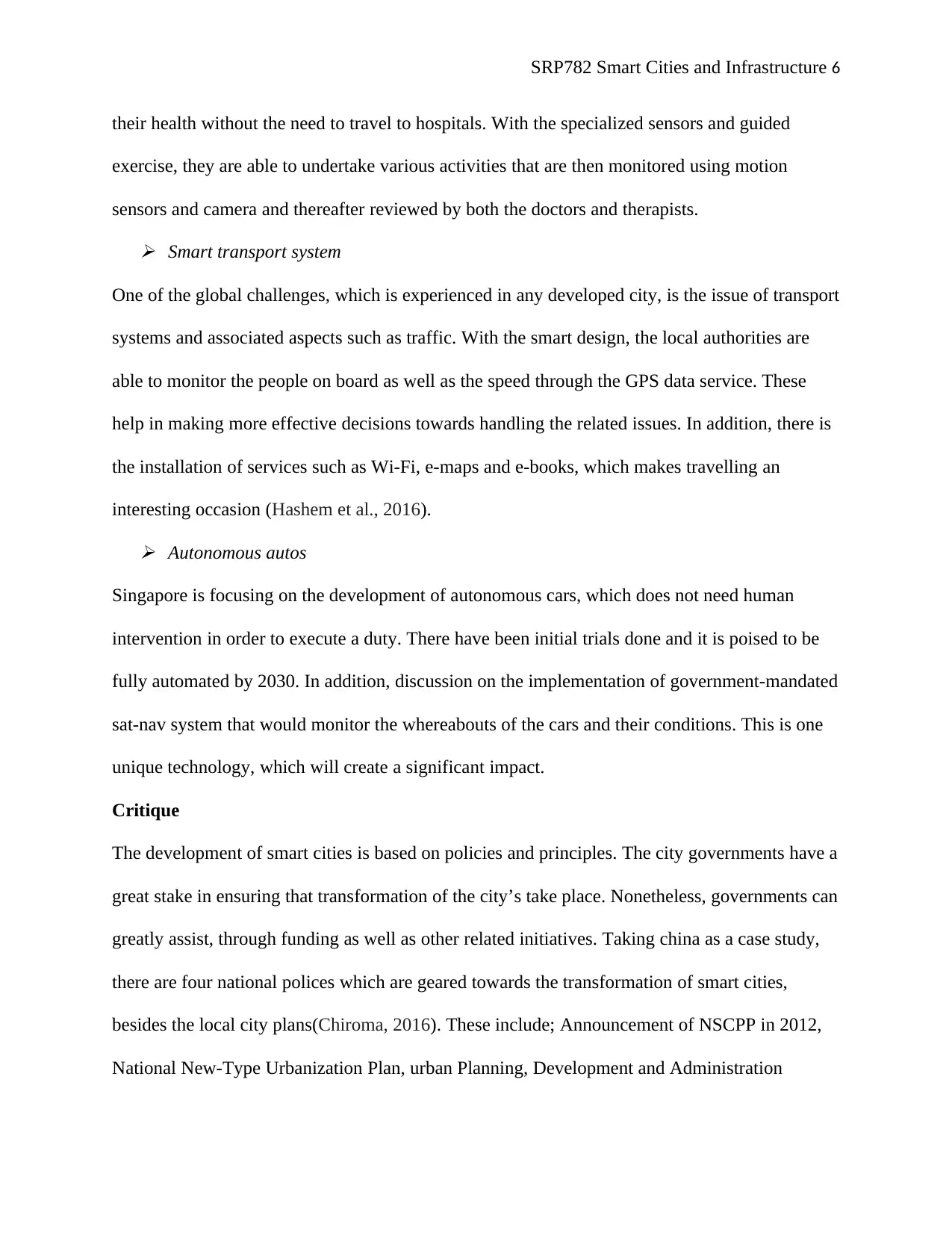
SRP782 Smart Cities and Infrastructure 6
their health without the need to travel to hospitals. With the specialized sensors and guided
exercise, they are able to undertake various activities that are then monitored using motion
sensors and camera and thereafter reviewed by both the doctors and therapists. Smart transport system
One of the global challenges, which is experienced in any developed city, is the issue of transport
systems and associated aspects such as traffic. With the smart design, the local authorities are
able to monitor the people on board as well as the speed through the GPS data service. These
help in making more effective decisions towards handling the related issues. In addition, there is
the installation of services such as Wi-Fi, e-maps and e-books, which makes travelling an
interesting occasion (Hashem et al., 2016). Autonomous autos
Singapore is focusing on the development of autonomous cars, which does not need human
intervention in order to execute a duty. There have been initial trials done and it is poised to be
fully automated by 2030. In addition, discussion on the implementation of government-mandated
sat-nav system that would monitor the whereabouts of the cars and their conditions. This is one
unique technology, which will create a significant impact.
Critique
The development of smart cities is based on policies and principles. The city governments have a
great stake in ensuring that transformation of the city’s take place. Nonetheless, governments can
greatly assist, through funding as well as other related initiatives. Taking china as a case study,
there are four national polices which are geared towards the transformation of smart cities,
besides the local city plans(Chiroma, 2016). These include; Announcement of NSCPP in 2012,
National New-Type Urbanization Plan, urban Planning, Development and Administration
their health without the need to travel to hospitals. With the specialized sensors and guided
exercise, they are able to undertake various activities that are then monitored using motion
sensors and camera and thereafter reviewed by both the doctors and therapists. Smart transport system
One of the global challenges, which is experienced in any developed city, is the issue of transport
systems and associated aspects such as traffic. With the smart design, the local authorities are
able to monitor the people on board as well as the speed through the GPS data service. These
help in making more effective decisions towards handling the related issues. In addition, there is
the installation of services such as Wi-Fi, e-maps and e-books, which makes travelling an
interesting occasion (Hashem et al., 2016). Autonomous autos
Singapore is focusing on the development of autonomous cars, which does not need human
intervention in order to execute a duty. There have been initial trials done and it is poised to be
fully automated by 2030. In addition, discussion on the implementation of government-mandated
sat-nav system that would monitor the whereabouts of the cars and their conditions. This is one
unique technology, which will create a significant impact.
Critique
The development of smart cities is based on policies and principles. The city governments have a
great stake in ensuring that transformation of the city’s take place. Nonetheless, governments can
greatly assist, through funding as well as other related initiatives. Taking china as a case study,
there are four national polices which are geared towards the transformation of smart cities,
besides the local city plans(Chiroma, 2016). These include; Announcement of NSCPP in 2012,
National New-Type Urbanization Plan, urban Planning, Development and Administration
⊘ This is a preview!⊘
Do you want full access?
Subscribe today to unlock all pages.

Trusted by 1+ million students worldwide
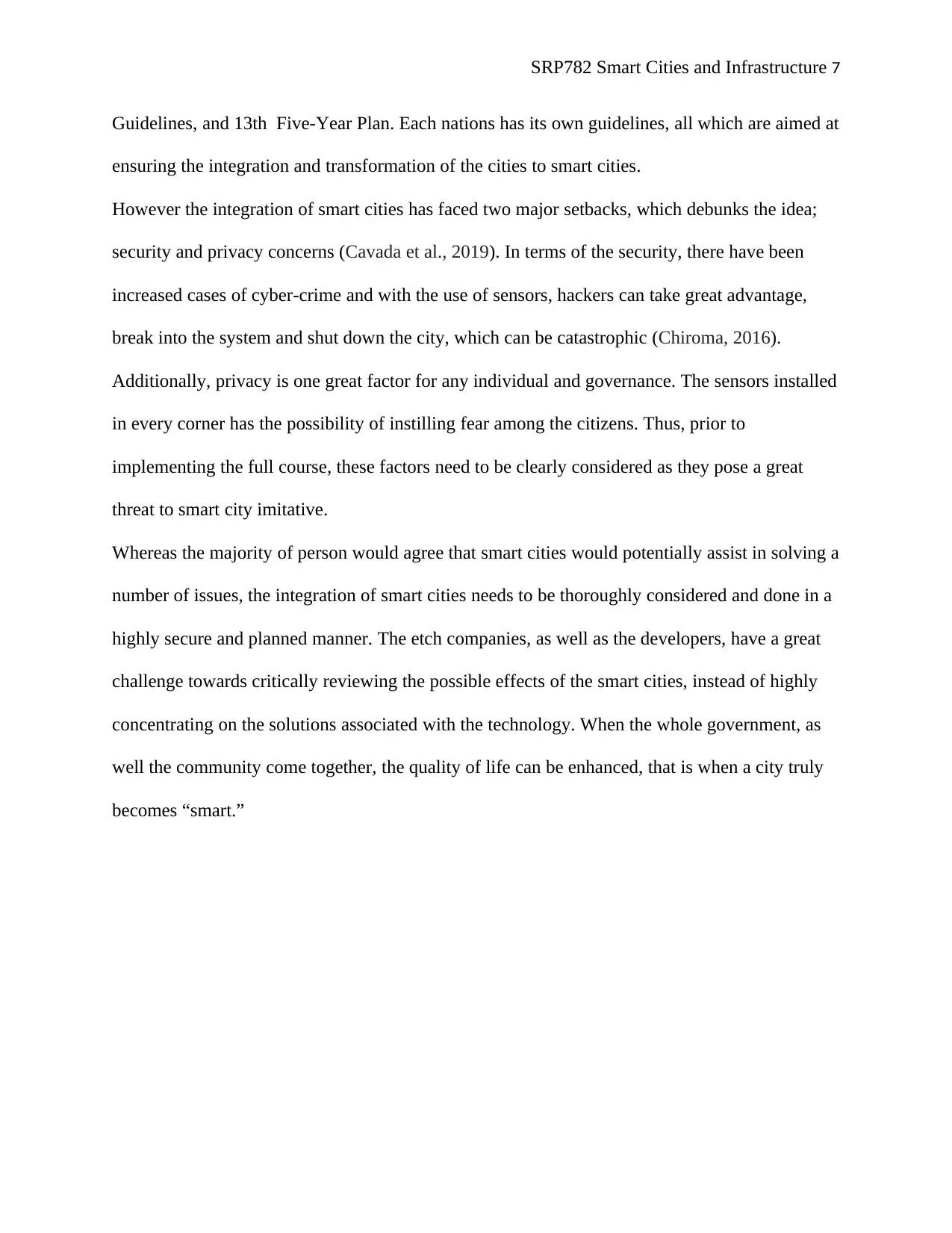
SRP782 Smart Cities and Infrastructure 7
Guidelines, and 13th Five-Year Plan. Each nations has its own guidelines, all which are aimed at
ensuring the integration and transformation of the cities to smart cities.
However the integration of smart cities has faced two major setbacks, which debunks the idea;
security and privacy concerns (Cavada et al., 2019). In terms of the security, there have been
increased cases of cyber-crime and with the use of sensors, hackers can take great advantage,
break into the system and shut down the city, which can be catastrophic (Chiroma, 2016).
Additionally, privacy is one great factor for any individual and governance. The sensors installed
in every corner has the possibility of instilling fear among the citizens. Thus, prior to
implementing the full course, these factors need to be clearly considered as they pose a great
threat to smart city imitative.
Whereas the majority of person would agree that smart cities would potentially assist in solving a
number of issues, the integration of smart cities needs to be thoroughly considered and done in a
highly secure and planned manner. The etch companies, as well as the developers, have a great
challenge towards critically reviewing the possible effects of the smart cities, instead of highly
concentrating on the solutions associated with the technology. When the whole government, as
well the community come together, the quality of life can be enhanced, that is when a city truly
becomes “smart.”
Guidelines, and 13th Five-Year Plan. Each nations has its own guidelines, all which are aimed at
ensuring the integration and transformation of the cities to smart cities.
However the integration of smart cities has faced two major setbacks, which debunks the idea;
security and privacy concerns (Cavada et al., 2019). In terms of the security, there have been
increased cases of cyber-crime and with the use of sensors, hackers can take great advantage,
break into the system and shut down the city, which can be catastrophic (Chiroma, 2016).
Additionally, privacy is one great factor for any individual and governance. The sensors installed
in every corner has the possibility of instilling fear among the citizens. Thus, prior to
implementing the full course, these factors need to be clearly considered as they pose a great
threat to smart city imitative.
Whereas the majority of person would agree that smart cities would potentially assist in solving a
number of issues, the integration of smart cities needs to be thoroughly considered and done in a
highly secure and planned manner. The etch companies, as well as the developers, have a great
challenge towards critically reviewing the possible effects of the smart cities, instead of highly
concentrating on the solutions associated with the technology. When the whole government, as
well the community come together, the quality of life can be enhanced, that is when a city truly
becomes “smart.”
Paraphrase This Document
Need a fresh take? Get an instant paraphrase of this document with our AI Paraphraser
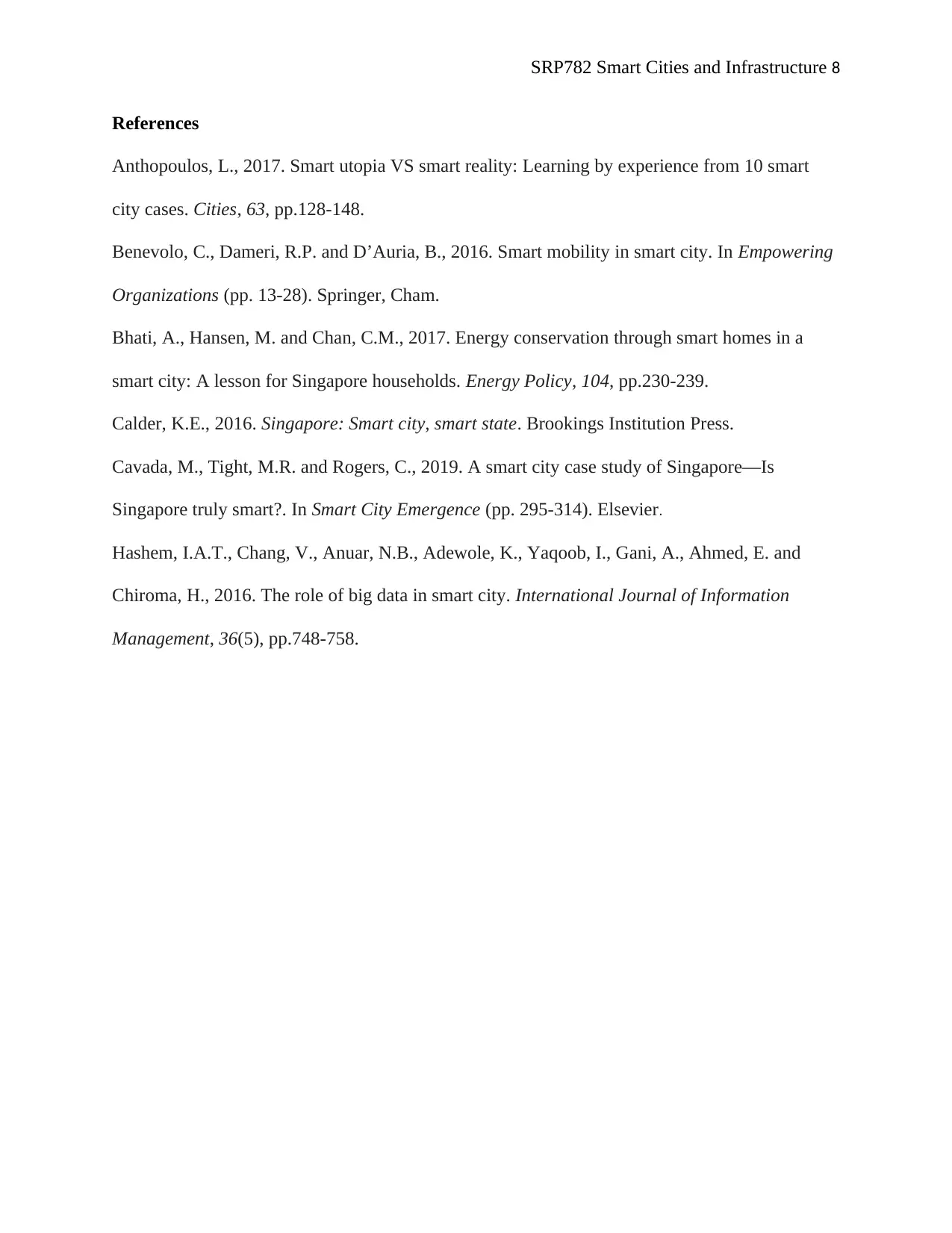
SRP782 Smart Cities and Infrastructure 8
References
Anthopoulos, L., 2017. Smart utopia VS smart reality: Learning by experience from 10 smart
city cases. Cities, 63, pp.128-148.
Benevolo, C., Dameri, R.P. and D’Auria, B., 2016. Smart mobility in smart city. In Empowering
Organizations (pp. 13-28). Springer, Cham.
Bhati, A., Hansen, M. and Chan, C.M., 2017. Energy conservation through smart homes in a
smart city: A lesson for Singapore households. Energy Policy, 104, pp.230-239.
Calder, K.E., 2016. Singapore: Smart city, smart state. Brookings Institution Press.
Cavada, M., Tight, M.R. and Rogers, C., 2019. A smart city case study of Singapore—Is
Singapore truly smart?. In Smart City Emergence (pp. 295-314). Elsevier.
Hashem, I.A.T., Chang, V., Anuar, N.B., Adewole, K., Yaqoob, I., Gani, A., Ahmed, E. and
Chiroma, H., 2016. The role of big data in smart city. International Journal of Information
Management, 36(5), pp.748-758.
References
Anthopoulos, L., 2017. Smart utopia VS smart reality: Learning by experience from 10 smart
city cases. Cities, 63, pp.128-148.
Benevolo, C., Dameri, R.P. and D’Auria, B., 2016. Smart mobility in smart city. In Empowering
Organizations (pp. 13-28). Springer, Cham.
Bhati, A., Hansen, M. and Chan, C.M., 2017. Energy conservation through smart homes in a
smart city: A lesson for Singapore households. Energy Policy, 104, pp.230-239.
Calder, K.E., 2016. Singapore: Smart city, smart state. Brookings Institution Press.
Cavada, M., Tight, M.R. and Rogers, C., 2019. A smart city case study of Singapore—Is
Singapore truly smart?. In Smart City Emergence (pp. 295-314). Elsevier.
Hashem, I.A.T., Chang, V., Anuar, N.B., Adewole, K., Yaqoob, I., Gani, A., Ahmed, E. and
Chiroma, H., 2016. The role of big data in smart city. International Journal of Information
Management, 36(5), pp.748-758.
1 out of 8
Related Documents
Your All-in-One AI-Powered Toolkit for Academic Success.
+13062052269
info@desklib.com
Available 24*7 on WhatsApp / Email
![[object Object]](/_next/static/media/star-bottom.7253800d.svg)
Unlock your academic potential
Copyright © 2020–2025 A2Z Services. All Rights Reserved. Developed and managed by ZUCOL.



